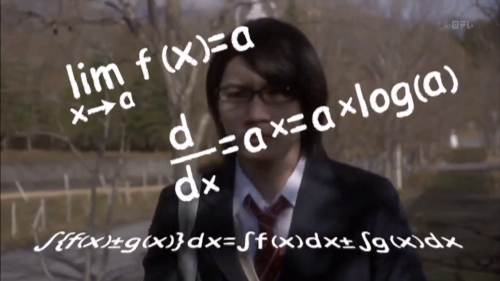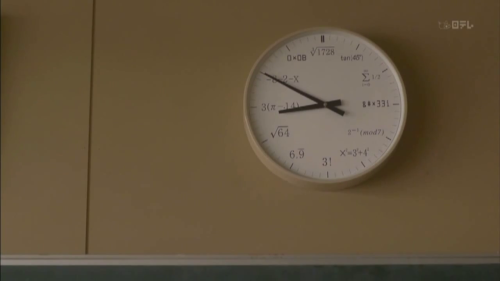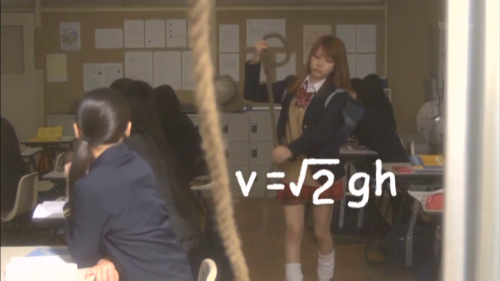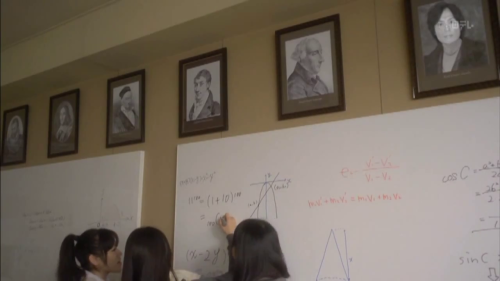You are currently browsing the tag archive for the ‘Series’ tag.
I’ve been a bit slow in responding to the new math drama Suugaku♥Joshi Gakuen starring a whole bunch of H!P members, but now that the first episode is out, here’s a post.
H!P math drama??!!! I’ve been waiting for this my whole life! (Never mind that my life predates H!P.) And of course I’m happy to see Sayu starring as a math geek, given the interest she’s expressed in the subject.
I don’t have time right now to do a full review of the first episode, but I’ve found it quite awesome so far, with respect to the geekiness, though the number of typos I’ve spotted have been quite a distraction. The series has apparently been developed in cooperation with the Mathematical Olympiad Foundation of Japan, so the math is essentially correct, as far as I can tell so far (I haven’t dissected most of it yet), though the editing work seems to have been rather sloppy.
Also, I’m not sure who’s planning to fansub this drama, but I would like to volunteer as a math consultant. So if you are working on this, please sign me up. I think the kinds of mistakes that have slipped through the editing can also pop up in translation, and I can help look over the translations and correct any possible math errors.
Here are some typos (and non-typos) I’ve found:
The first equation is given as . This says that the limit of f(x) as x approaches a is equal to a. As written, this is only correct for all values of a if f is the identity function. This should probably be
, which is true for all continuous functions.
The second equation says . There is an extra equal sign here. It should be
. This is the derivative of ax respect to x.
The third equation is fine as is, and expresses linearity of integration.
This clock is just awesome. It has expressions evaluating to or otherwise indicating each of the integers from 1 to 12, which we would see on a normal clock.
-
— the tangent of 45°, equal to 1.
-
— this is a typo; should be
, an infinite series converging to 2.
- 3i — this is another typo; should be 3, an HTML code for the character 3.
-
— the modular multiplicative inverse of 2 (mod 7); 4 and 2 multiply to 8, which is congruent to 1 (mod 7), so 4 is an inverse of 2 (though not the only inverse; 11 is the other integer on the clock that satisfies this property, which makes this a flawed clock).
-
— solve for X, which can be either 5 or -5.
-
— the factorial of 3, which is 6.
-
— this repeating decimal is equal to 7.
-
— the square root of 64 is 8.
-
— since π is irrational, this is actually 9.004777960769…, but it’s approximately 9.
-
— solve for X, which is 10.
- 0x0B — hexadecimal for 11, with the standard hexadecimal prefix of “0x” used in Unix-like shells and C.
-
— the cube root of 1728 is 12.
This is given as , but the radical should extend over the entire right-hand side:
.
In context, Nina (Reina’s character) swings on a rope into the classroom. This expresses her velocity at the lowest point of her trajectory.
Nina starts out with a gravitational potential energy of mgh (m is mass, g is gravitational acceleration, and h is height, measured relative to the lowest point of her trajectory) and no kinetic energy prior to swinging on the rope. At the lowest point, she has a kinetic energy of (m is mass and v is velocity) and no potential energy. Due to conservation of energy, these two are equal:
It seems Tsunku♂ has joined the eminent ranks of Napier, Fermat, Gauss, Cauchy, Lagrange, et al…. :o
… I’ve just been busy, sorry.
Busy with what, you ask?
Well … I’ve been living it up (?) as a graduate teaching assistant for a course in mathematics for computer science, taken mostly by second-year undergrads, with a total enrollment of around ~180. As part of my duties, I get to teach two sections that meet twice a week and also contribute to writing problems for assignments and quizzes. What fun!
Actually, the making-up-awesome-problems part really is fun! I managed to whip together an entire problem set on the topic of sums and asymptotic relations in which all the problems are Hello! Project-themed.
Alas, after discussion with the other staff members, we decided that while the problems were awesome and hilarious (maybe more so for me than for them), they were a bit on the challenging side, not straightforward enough, and touched on a few topics we weren’t really covering (Problem 4d in particular “would kill the students”). So it got scratched, and a more boring replacement was released instead.
But all is not lost! We’ve decided to release this problem set as optional, not-for-credit “challenge problems”, and you can try them out here:
Hello! Project Challenge Problems (PDF)
If you wish, you can send your solutions to kirarinsnow@mit.edu, and I’ll respond with comments.
Enjoy!






Recent Comments